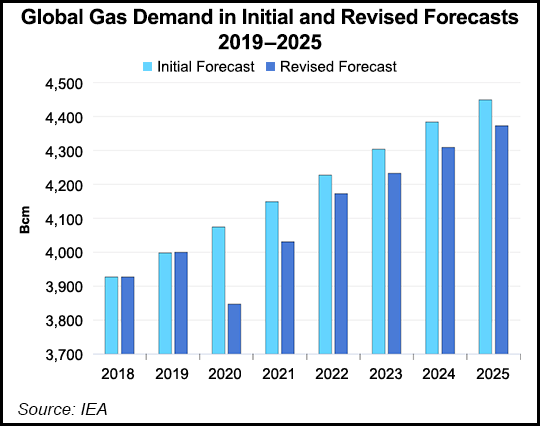NGI The Weekly Gas Market Report | LNG | LNG Insight | Markets | NGI All News Access
Global Natural Gas Consumption Facing ‘Historic Shock’ in 2020, with Demand Set to Fall by 4%
The pandemic and a mild winter in the northern hemisphere have delivered a “historic shock” to the global natural gas market, with consumption set to decline in 2020 by twice the amount lost after the 2008 financial crisis, the International Energy Agency (IEA) said Wednesday.

The global energy watchdog in its annual market report Gas 2020 said demand is on course for its largest annual decline in history, with consumption forecast to fall by 4%, or 150 billion cubic meters (Bcm), which is double the loss following the 2008 financial crisis.
“Natural gas has so far experienced a less severe impact than oil and coal, but it is far from immune from the current crisis,” IEA executive director Fatih Birol said. “The record decline this year represents a dramatic change of circumstances for an industry that had become used to strong increases in demand.”
Liquefied natural gas (LNG) should remain the main driver for international trade but mirroring forecasts by other researchers, IEA expects to see much slower demand across the export spectrum in the near term.
“The wave of investment in LNG projects during 2018 and 2019 will bring additional export capacity in North America, Africa and Russia,” researchers said. “Slower growth in global gas demand in the coming years is likely to result in capacity outpacing LNG imports through 2025, limiting the risk of a tight LNG market for the time being.”
New production and infrastructure projects should continue to come online but growth trends are “markedly below earlier expectations, reinforcing the prospect of overcapacity and low prices,” researchers said. “This casts a shadow over future investments, which will be needed in the long term to ensure the renewal of production sources and global security of supply.”
As of early June, all major gas markets worldwide were experiencing a sharp decline in demand or growth, researchers said. More mature markets across Europe, North America and Asia are forecast to see the biggest drops this year, accounting for 75% of the total decline.
Global oversupply has pushed indices to record lows, while the oil and gas industry is slashing spending and postponing investment decisions to make up for the shortfall in revenue.
A rebound is expected in 2021, but don’t assume a rapid return to the pre-crisis trajectory.
“Global gas demand is expected to gradually recover in the next two years, but this does not mean it will quickly go back to business as usual,” Birol said. “The Covid-19 crisis will have a lasting impact on future market developments, dampening growth rates and increasing uncertainties.”
Most of the demand gains after 2021 are likely to come from emerging Asian areas, led by China and India where gas benefits from strong policy support. “In both countries, the industrial sector is the main source of demand growth, making it highly dependent on the pace of the recovery in domestic and export markets for industrial goods,” researchers said.
The Covid-19 aftermath should result in 75 Bcm of lost annual demand by 2025, around the same amount as the increase in global demand in 2019, IEA estimated.
The Lower 48, which is one of the main drivers of future supply growth, along with large conventional projects in the Middle East and Russia, “are also under pressure from the current oil price collapse and uncertainty surrounding demand trends over the short and medium term.”
© 2024 Natural Gas Intelligence. All rights reserved.
ISSN © 1532-1231 | ISSN © 2577-9877 | ISSN © 1532-1266 |
